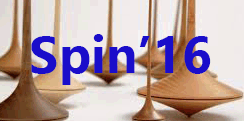Conveners
Beyond SM: Parallel I
- Buddhini Waidyawansa
Beyond SM: Parallel IV
- David Kawall
Beyond SM: Parallel V
- Buddhini Waidyawansa
Beyond SM: Parallel VI
- David Kawall
Description
Fundamental Symmetries and Spin Physics Beyond the Standard Model
We discuss the measurements of parity-violating asymmetries in DIS region (PVDIS) using SoLID spectrometer at JLab Hall A in the 12 GeV era. Mea-surements with polarized electron beam on unpolarized deuteron and proton targets have been approved with an A rating. The deuteron measurement aims to measure weak mixing angle sin2(θW) with precision of ± 0.0006 as well as access a fundamental...
The observation of the transformation of a neutron into an antineutron would reveal that B-L symmetry is broken and thus that dynamics beyond the Standard Model exists. Notably it would establish that neutrons can act as their own antiparticles, making the process a hadronic analog to neutrinoless double beta decay. I will discuss the role of spin, highlighting how external fields or sources...
Electric Dipole Moments (EDM) of elementary particles including hadrons, are considered as one of the most powerful tools to discover CP violation beyond the Standard Model. Such CP violating mechanisms are required to explain the dominance of matter over anti-matter in our universe. Up to now experiments concentrated on neutral systems (neutron, atoms, molecules). Storage rings offer the...
A permanent electric dipole moment (EDM) of the isotope 129Xe would imply a breakdown of both parity P and time reversal symmetry T and, through the CPT theorem, a breakdown in CP, the combined symmetries of charge conjugation C and parity P. Our goal is to improve the present experimental limit (dXe < 3 · 10−27 ecm) by about three orders of magnitude. The most precise EDM limit on diamagnetic...
Searches for permanent electric dipole moments (EDMs) are sensitive to time-reversal, parity, and charge-parity (CP) violation, and, as such, are excellent probes for physics beyond the Standard Model. 225Ra (t1/2=15d, I=1/2) is a particularly attractive system to use for an EDM search because its large nuclear octupole deformation makes it uniquely sensitive to CP violating interactions in...
In the Spallation Neutron Source based neutron Electric Dipole Moment (SNS nEDM) experiment, spins of polarized ultracold neutrons and polarized 3He will be manipulated in a 0.3 - 0.5 K superfluid 4He bath. Measurements will be made using two different modes: free precession and critical dressed spin. In the former, both spin species undergo a π/2 flip and then precess at their Larmor...
Precision measurements of the anomalous magnetic moment of the muon, aµ ≡ (gµ − 2)/2, provide an excellent test of the Standard Model with sensitivity to physics beyond the Standard Model. The most recent measurement of aµ at Brookhaven National Laboratory (E821) differs from the Standard Model prediction by roughly 3.5 standard deviations. Currently under construction at Fermilab is a new...
The J-PARC E34 experiment aims to measure the anomalous magnetic moment (g-2) and electric dipole moment (EDM) of the positive muon with a novel technique utilizing an ultra-cold muons accelerated to 300 MeV/c and a 66 cm-diameter compact muon storage ring without focusing electric field. This measurement will be complementary to the previous BNL E821 experiment and upcoming FNAL E989...
The Universe around us consist mainly of matter although it is assumed that in the Big Bang an equal amount of antimatter has been produced. The Standard Model prediction for the proportion for the number of the baryons and antibaryons differs from the Astrophysical observations by eight orders of magnitude. To explain this phenomenon, which is usually called the Baryon Asymmetry of the...
Parity Violating Electron Scattering (PVES) is an extremely successful precision frontier tool that have been used for testing the Standard Model (SM) and understanding nucleon structure. Several generations of highly successful PVES programs at SLAC, MIT-Bates, MAMI-Mainz, and Jefferson Lab have contributed to understanding of nucleon structure and testing the SM. But missing phenomena like...
